Browse using the new Vinous website now. Launch →
Printed by, and for the sole use of . All rights reserved © 2015 Vinous Media
2016 Bordeaux: It’s Now or Never, Baby
BY ANTONIO GALLONI | APRIL 25, 2017
The 2016 growing season presented château owners with plenty of challenges, but ideal weather at the most critical time of the year made up for the early struggles of the vintage. The best 2016s are deep and intense, yet also pulse with a real sense of energy. For the 2016s to be successful in the market, however, owners will have to be sensible with prices. That’s why for Bordeaux It’s Now or Never, Baby.
The 2016 Growing Season
The 2016 growing season did not get off to an auspicious start. Rain during the first three months of the year was three times the historical average. Warmer than normal temperatures led to an early budbreak, which is always a concern, as it exposes the vines to severe damage in the event of frost. Temperatures dropped into the spring and vegetative growth slowed. A window of serene conditions opened just in time for flowering, which took place under benign conditions that allowed for a fast and even set. Potential yields, which are always determined by the pre-formation of clusters in the previous year, looked to be abundant.
Temperatures soared above historical averages during the summer months, especially during July and August, both of which saw the vines receive more sunlight than either of the two preceding vintages. Rain, such a constant during the early part of the season, was essentially non-existent in July and August. Curiously, while daytime temperatures were above historical averages, nighttime temperatures were cooler than average, which is an unusual combination. Heat and lack of rain took the vineyards into hydric stress and caused sugar accumulation to stop.
Rains in mid-September could not have been more opportune. Parched vines responded positively and ripening resumed. By this time, daytime highs began to moderate while the nights remained cool. Average temperatures had moved to below historical averages. One of the key elements of 2016 is that the final phase of ripening took place in September and October, a time of year when the days are shorter and the nights are longer than they are in July and August. In 2016, this phenomenon was accentuated by wide diurnal shifts between daytime highs and nighttime lows. Strong diurnal shifts are essential for the development of color and aromatics.

Tour Saint Christophe as seen from Barde-Haut, Saint Émilion
In most years, rain and disease pressure start to become an issue in the fall, but in 2016, conditions remained stable throughout the end of the season, which gave winemakers and vineyard managers the luxury of harvesting at their choosing. The late harvest allowed for the full maturation of tannins, one of the many hallmarks of the 2016 vintage. Most properties brought in their fruit from late September to mid October.
As predicted, yields were generous across the board. One exception is Cabernet Sauvignon. A number of winemakers commented that by the time much of the fruit came in, the berries were small and the juice yields were lower than expected. Quality in many cases is exceptional, but one result of the lower yields in Cabernet is that a number of wines in the Médoc have less Cabernet in their blends than normal.
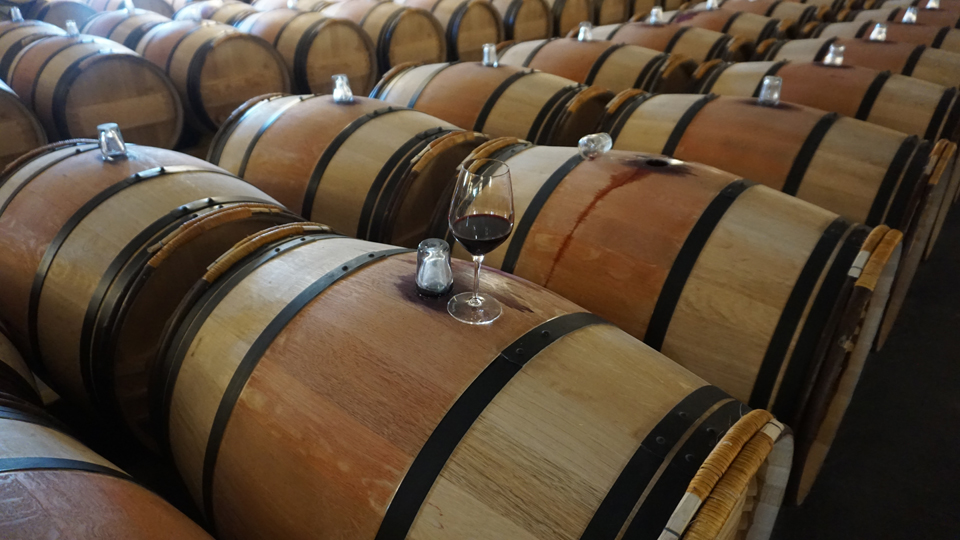
Tasting the 2016 Mouton Rothschild in barrels from the main coopers used in the blend of Grand Vin
2016 Bordeaux: A Game Changer?
The 2016s are absolutely remarkable wines. The word that comes to mind, unfortunately so often overused, is balance. In technical terms, the 2016s boast off the charts tannins that in many cases exceed those of wines from massive vintages such as 2010. And yet, the best 2016s are absolutely harmonious, with the tannins barely perceptible at all. The 2016s also have tremendous energy and bright, acid-driven profiles, with many wines playing more in the red-fruit area of the flavor spectrum. One of the results of the unusual growing season is that alcohols range from 0.5% to 1% lower than what has been the norm in recent years.
From a stylistic standpoint, the recent vintage that comes to mind is 2014, also a late-ripening year, but the 2016s have more mid palate depth and greater density. Some observers have suggested that 2016 is a hypothetical blend of 2009 and 2010, but I fear that is mostly an attempt to recreate the hype of those two highly speculative vintages. The 2016s don’t have the opulence or volume of the 2009s, and although they are very tannic, they feel nothing like the overtly powerful, structured 2010s.
Intuitively, it makes sense that a late-ripening vintage might favor Cabernet Sauvignon, especially given the intense heat of the summer that cause sunburn and overripeness in some of the Merlots. But a more in-depth analysis reveals that 2016 has much to offer on both banks. Excellence is highly correlated with quality of site, regardless of whether those vineyards are on the Left or Right Banks. Specifically, moisture-retentive sites and older vineyards with deeper root systems fared best.
Not all Cabernet Sauvignon-based wines are overachievers, while many Right Bank wines are.
Many producers opted for longer macerations (time on the skins) than normal, but at lower temperatures and with gentler extractions than in the past. It will be interesting to see if one of the outcomes of 2016 is a move towards greater finesse and less overt power than in the past. Almost all of the winemakers I spoke with told me they think the 2016s are more a reflection of the vintage than in any large scale changes in philosophy and that the next time a riper vintage presents itself the wines will once again be built on opulence. I am not so sure. Two thousand sixteen is a vintage that will be thought provoking on many levels for years, and probably decades, to come.
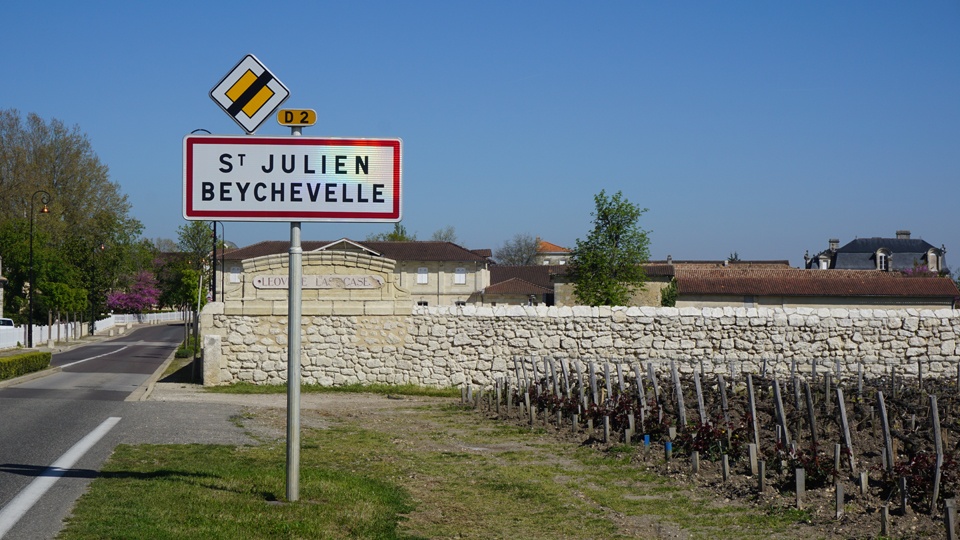
The entrance to Saint-Julien, where many of the finest 2016s of the Left Bank are found
The Left Bank: Saint-Julien Stars
If there is one commune on the Left Bank where quality is exceptional across the board, it is without question Saint-Julien. Most vintages have a sweet spot or two. In 2014, it was the northern Médoc, Saint-Estèphe in particular, that benefitted most from the Indian summer. Last year, quality in Margaux was superb, as it was in a number of pockets on the Right Bank. Saint-Julien is the unquestioned star of 2016.
An uncharacteristically refined Léoville-las-Cases and a gorgeous Ducru Beaucaillou lead the pack, but readers will also find a sublime Branaire-Ducru an unusually exotic Beychevelle, a fabulous Léoville-Poyferré, a regal Léoville-Barton, along with a number of other stunningly beautiful, compelling wines. Even better, many of the second wines from Saint-Julien are absolutely delicious and will give readers a good look at the quality of the year before the big guns are ready to deliver maximum pleasure.
Neighboring Pauillac is larger than Saint-Julien, so quality is naturally more variable, but the best Pauillacs are magnificent. Pichon-Lalande is a must-have, Mouton-Rothschild is tremendous, while Lafite-Rothschild, Latour and Pontet-Canet are all sublime. The 2016 Pauillacs are marked by extraordinary purity of fruit, even among the lesser châteaux. Of course, it is very early, and some of the rusticity that is found in the more modest properties may well emerge over time, but today, the Pauillacs are quite impressive.
In Saint-Estèphe, the wines are very good, but quality is mixed. Calon-Ségur and Phélan Ségur are both overachievers, but most other wines, while excellent to outstanding, don’t necessarily punch above their weight. Montrose is still very raw to the point of being monolithic, while Cos d’Estournel is unusually delicate and medium in body. A number of less touted properties did well in 2016, which is a positive, and also great news for consumers looking for value, but overall, the Saint-Estèphes aren’t as consistently brilliant as the wines of other appellations.
In the southern Médoc, readers will find plenty of terrific wines from the better properties in Margaux, although 2016 is not the across-the-board success that 2015 was. Macau, which is just south, is a fertile hunting ground for value-priced reds that deliver high quality.

Technical Director Nicolas Glumineau and his team made one of the wines of the vintage at Pichon-Lalande
The Right Bank Dazzles
I tasted a large number of absolutely stunning wines on the Right Bank. The brutally dry summer was especially penalizing to younger vineyards. Moisture retentive soils and vineyards with deep root systems where the vines could access water during the summer did best. In some places, hydric stress was highly problematic. I tasted some wines with a distinctly roasted, overripe character, especially in Merlot, while the intense heat also affected some of the Cabernet Franc. But where conditions were less extreme and where producers were able to cull out lower quality fruit, the wines are simply dazzling. The 2016 Right Bank reds are remarkably polished and sensual. Even wines like Trotanoy that are often broad and powerful show a level of finesse that is quite rare at this early stage. In Pomerol, Vieux Château Certan, Le Pin, Pétrus, Lafleur and L’Eglise Clinet are all knockouts. Cheval Blanc, La Conseillante, L’Evangile, Figeac, Pavie, Pavie-Macquin, Larcis Ducasse and Beauséjour Héritiers Duffau-Lagarrosse are among the most exceptional wines of Saint-Émilion.
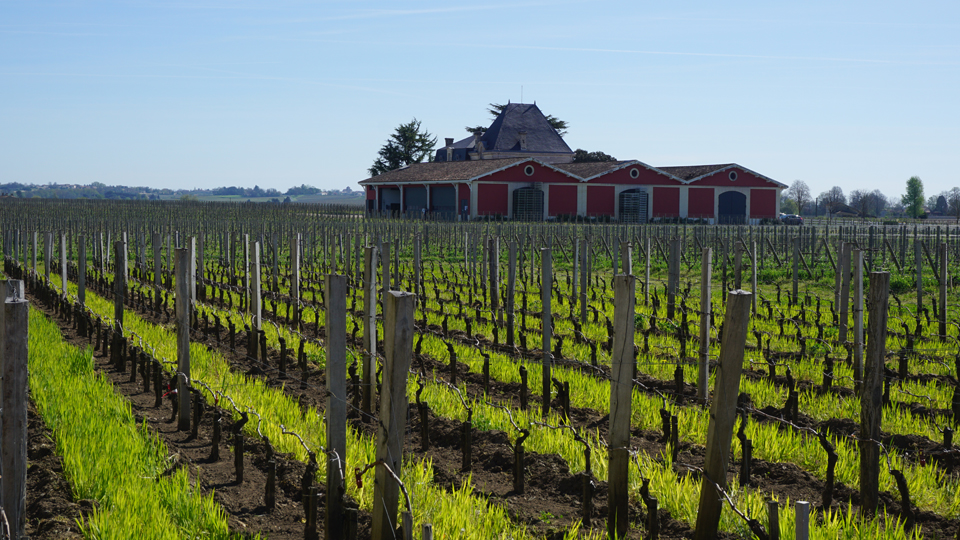
L’Evangile as seen from La Conseillante, Pomerol
Pessac & Léognan Reds
The theme of brightness, elegance and finesse carries over the communes of Pessac and Léognan, where the wines are often powerful, virile, and in some cases, also quite rustic. Smith Haut Lafitte, Domaine de Chevalier and Haut Bailly are both absolutely brilliant, both in quality and personality, while La Mission Haut-Brion and Haut-Brion express all the pedigree of their respective sites. Partially because of its high percentage of Cabernet Franc and fermentation with whole clusters, Les Carmes Haut-Brion remains the most distinctive wine of the sector.
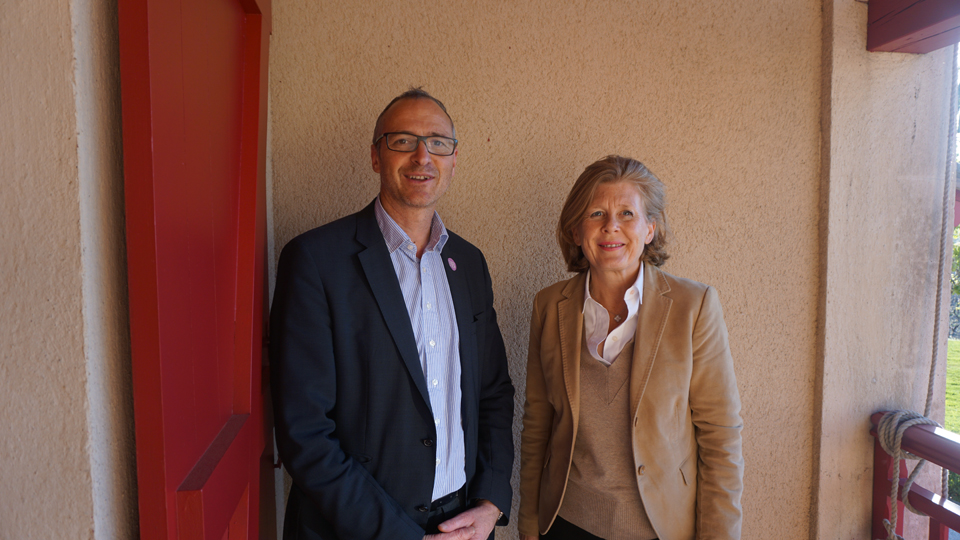
Haut-Bailly's Gabriel Vialard and Véronique Sanders
Dry & Sweet Whites
As compelling as 2016 is for reds, it is a far less interesting vintage for dry whites. The summer conditions were not favorable for the production of high quality whites on a par with the best vintages. Sémillon was especially challenged. For that reason, and in order to give the wines as much freshness as was available, producers made a decision to favor Sauvignon Blanc over Sémillon in the blends. Overall, the 2016 whites are blowsy and lacking in both focus and energy. With a few exceptions, the 2016s come across as wines that are best enjoyed on the young side.
The sweet whites of Sauternes and Barsac fared better than Bordeaux’s dry whites. Late season rains created good conditions for the onset of noble rot. In general, the 2016s sweet wines are open-knit and gracious, qualities that will make them easy to enjoy relatively early. I don’t see the precision or energy of truly great years such as 2013, but 2016 is certainly a pleasant, above average vintage with a number of overachievers.
Looking for Value
As always, most of the attention this time of year focuses on Bordeaux’s top estates and most famous wines. But Bordeaux is so much more than just 20-30 elite properties. Readers will find a bevy of affordable wines in this article and my accompanying piece 2016 Bordeaux: 30 Top Values. The Haut-Médoc and various satellite appellations on the Right Bank, most notably Fronsac, are all worth discovering. These regions excel with delicious, flavorful wines of real pedigree that the average consumer can still afford to buy. Wines listed in Sleepers & Under the Radar Gems, while not all inexpensive, do offer serious quality and tons of relative value.

The cramped cellar at L’If, Saint-Émilion
And Then There is the Market…
The big question now for the 2016s is price. Every spring, the same debates ensue around the market for Bordeaux wines. Some people believe the en primeur system is broken, obsolete, or both. I am more inclined to think issues with wines selling through are more related to pricing than just structural factors. As of this writing the few estates that have released pricing have done so at 2015 levels, which is a highly encouraging sign.
This year there are a number of factors at play. One of these is volume. In 2016, total production is estimated at around 6 million hectoliters, which is equivalent to 800 million bottles of wine. Some of that is, of course, very inexpensive, low quality wine. Even so, the numbers are staggering when compared with other regions like Champagne (itself considered a very large region) with its annual production of 330 million bottles, or Burgundy, which produces around 200 million bottles (both red and white) in good year.
The UK, one of Bordeaux’s oldest and strongest markets, has seen the GBP lose approximately 15% relative to the EUR over the last year. It doesn’t take a rocket scientist to understand that even if prices remain unchanged, the UK consumer is looking at 15% increase over the 2015s, which is not an easy proposition. And of course, any meaningful increase over the 2015s could be utterly crushing to the UK consumer’s interest in the 2016s. From what I have been told by those in the know, interest in futures does not appear to be especially strong across Asian markets. As if that were not enough, the macro geopolitical and economic outlook in many parts of the world is best described as highly uncertain.

Terracotta amphoras at Les Carmes Haut-Brion, Bordeaux
In this climate, most businesses would take the sure cash, even if it means sacrificing some upside. Who knows what the world will look like when the 2015s and 2016s are sold in bottle, or what the 2017 harvest will bring? No one. Châteaux that raise their prices by more than 5-10% in this kind of environment are telling the world they don’t really need the money from the futures campaign and have the financial wherewithal to handle sitting on unsold wine. There is nothing wrong with that per se, but that is the message.
No one needs a $50 or $100 wine, much less a bottle that costs many times that. But we as consumers are often willing to spend sums of money most normal people consider insane for a bottle of wine. Why? Because of the intangibles that make the world’s best wines the objects of desire. When it comes to Bordeaux, what I hear most often from consumers is this: “Buying futures is not fun anymore."
Even if investment is not the main objective, consumers who put down cash today for a wine that will be delivered in two years time and then may need a decade or more to be at its best want to see some return on that money. When owners raise prices to the level that virtually all of the economic rents accrue to them, they leave very little potential upside for members of the trade at various levels. For the consumer, wine is a passion, a hobby. And some element of buying wine has to remain fun.
Two thousand sixteen presents a great opportunity for owners to gain back a considerable amount of consumer confidence that has been lost in past years largely through the excessive pricing of some previous vintages. High production and an uncertain economic climate create easy, face-saving reasons to keep price increases modest without tarnishing the prestige that many estates have built up over time. If the 2016s do not sell well, it will be a damning indictment that one or more things is seriously wrong with how the wines are sold. That’s why 2016 is Now or Never for Bordeaux.
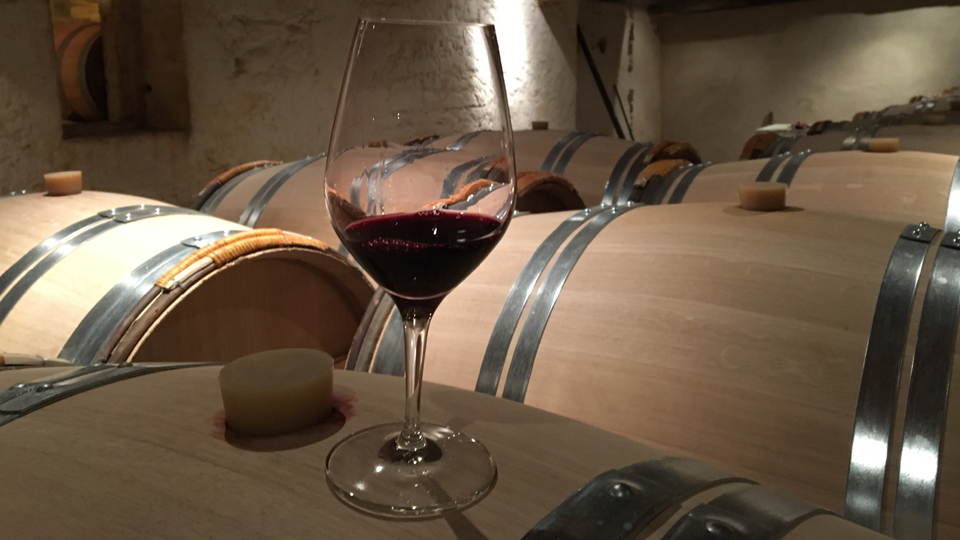
Tasting separate lots from barrel at Canon-La Gaffelière, January 2017
How to Use These Reviews
Bordeaux en primeur is a strange animal. Keeping in mind that most of the fruit was harvested between the end of September and the middle of October, the 2016s were less that six months old before they were presented as barrel samples to critics, journalists and the trade. Tasting wines that are six months old and trying to project what those wines will be like as bottled, finished products, much less what they will develop into with time in bottle, is clearly more art than science. For comparison, consider that in Burgundy, wines generally do not finish their malos before the summer and are only presented to outside tasters a full year or more after the harvest. In Napa Valley, I know of no single high quality wine that is blended before the summer after the harvest, and even those are preliminary blends that are rarely tasted by anyone outside the estates.
Châteaux have different ways of approaching en primeur tastings. Some properties present a finished blend that is representative of the entire production while others make no effort to hide that the en primeur samples are taken from barrels that are raised specifically with the goal of being ready for the spring tastings. Atmospheric pressure often plays a significant role in how wines show. Too much sulfur and a sample may not show well, too little and a wine can taste oxidized. I have also noticed that samples prepared in 750ml bottles often show better than those presented in 375ml bottles. For these reasons, I tasted many wines in this article more than once, some many more than once, and visited a number of properties two times.
Readers should view these tasting notes and the accompanying ratings as estimates as to a wine’s quality level and potential. Because the wines are not finished, scores are presented in brackets rather than as a single number. Scores are best interpreted for their directional value rather than as absolutes.
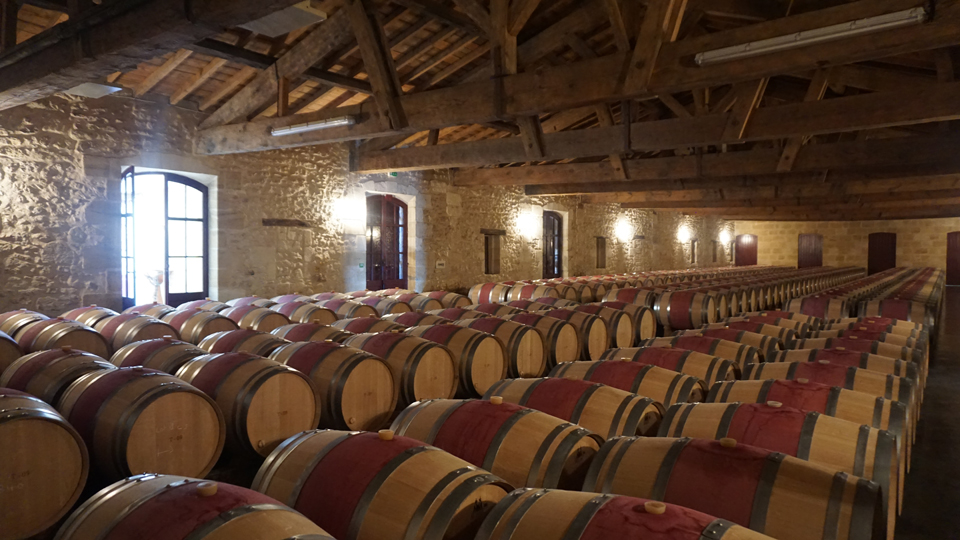
The barrel room at Pontet-Canet, Pauillac
How to Buy Bordeaux Futures
These are some tips on how to buy Bordeaux futures.
Work with Trusted Merchants
Always work with trusted merchants who have been in the game for a long time. Buying Bordeaux futures, which involves paying today for a wine you will receive in two years, involves a certain amount of risk. Not all retailers are the same.
Readers are best served by working with retailers who have been in the futures business for many years, or preferably, decades.
Relationships Matter More Than Prices
Everyone loves a good deal, but shopping on price alone will inevitably lead to disappointment, sooner or later. Establishing quality relationships with merchants is the best way to ensure access to the most coveted wines (from all regions) over the long term. That might occasionally involve paying a little more for a wine here or there. Think of it as an investment, and play the long game.
Be Meticulous About Records
I strongly advise readers keep receipts and use credit card companies that have strong consumer protection policies.
The Tastings
I started tasting the 2016s in January of this year. Those early tastings at a number of properties were a helpful means of getting an early look at the style and personality of the year before the wines are blended. For this report, I tasted the wines during the last week of March and the first week of April. In general, my preference is to taste as late as possible, especially for later-ripening vintages. I noted that many wines showed at their best towards the end of my trip, which is something I also saw with the 2014s. When wines are just five months old, a week between tastings can, and often does, make a big difference.
This article would not have been possible without the hard work of dozens, maybe hundreds, of people who work behind the scenes answering emails, taking care of scheduling and making sure that all the details are perfect when visitors arrive. Those efforts do not go unnoticed. I would like to thank everyone how played a role in organizing and setting up my tastings.
2016 Bordeaux: Sleepers & Under the Radar Gems
You Might Also Enjoy
2016 Bordeaux: 30 Top Values, Antonio Galloni, April 2017
Larcis Ducasse Retrospective: 1945-2014, Antonio Galloni, March 2017
2014 Bordeaux: A September Surprise, Antonio Galloni, February 2017
Mouton Rothschild: 2003-2015, Antonio Galloni, May 2016
Bordeaux’s Radiant 2015s, Antonio Galloni, April 2016
2012 Bordeaux: Messages in a Bottle, Antonio Galloni, January 2016
2014 Bordeaux – Vintage Highlights, Antonio Galloni, May 2015
2014 Bordeaux – Les Découvertes: Under the Radar Gems and Sleepers, Antonio Galloni, May 2015
2014 Bordeaux: It Ain't Over Till It’s Over, Antonio Galloni, April 2015
Show all the wines (sorted by score)
- Adaugusta
- A.D. Francos
- Alcée
- Ampélia
- Angélus
- Ausone
- au Vignoble
- Badette
- Balestard La Tonnelle
- Barde-Haut
- Barrail Saint-André
- Barthez
- Bastor-Lamontagne
- Beaumont
- Beauregard
- Beau-Séjour Bécot
- Beau Soleil
- Bel-Air (Bordeaux)
- Bel-Air (Lussac Saint-Émilion)
- Bélair-Monange
- Bel-Air-Ouÿ
- Bel-Air (Pomerol)
- Belgrave
- Belle Coline
- Bellefont-Belcier
- Bellegrave (Pauillac)
- Bellegrave (Pomerol)
- Belle-Vue
- Bellevue Mondotte
- Bellevue (Saint-Émilion)
- Berliquet
- Bernadotte
- Bernateau
- Bertineau Saint-Vincent
- Beychevelle
- Bolaire
- Bonalgue
- Bonnet
- Bourgneuf
- Boutillot
- Boutisse
- Branaire-Ducru
- Brane-Cantenac
- Brillette
- Cadet-Bon
- Calon Ségur
- Cambon La Pelouse
- Canon
- Canon La Gaffelière
- Canon Pécresse
- Cantegril
- Cantelys
- Cantemerle
- Cantenac Brown
- Cantin
- Capbern
- Cap de Faugères
- Capdemourlin
- Capet-Guillier
- Cap Léon Veyrin
- Cap St. George
- Carbonnieux
- Carignan
- Carlmagnus
- Carteau Côtes Daugay
- Certan de May
- Chantegrive
- Charmail
- Chasse-Spleen
- Château Beauséjour JDL
- Château Margaux
- Chauvin
- Cheval Blanc
- Citran
- Clarendelle
- Clarisse
- Claud-Bellevue
- Clauzet
- Clément-Pichon
- Clerc-Milon
- Climens
- Clinet
- Clos Badon
- Clos Bertineau
- Clos Chaumont
- Clos de Boüard
- Clos de la Vieille Église
- Clos de l’Église
- Clos de l'Oratoire
- Clos de Sarpe
- Clos des Baies
- Clos des Jacobins
- Clos des Lunes
- Clos des Menuts
- Clos des Prince
- Clos Dubreuil
- Clos du Clocher
- Clos du Marquis
- Clos du Roy
- Clos Floridène
- Clos Fourtet
- Clos La Madeleine
- Clos Les Grandes Versannes
- Clos L'Hermitage
- Clos Lunelles
- Clos Manou
- Clos Margalaine
- Clos Marsalette
- Clos Puy Arnaud
- Clos René
- Clos Romanile
- Clos Saint-Julien
- Clos Saint-Martin
- Clos Vieux Taillefer
- Corbin
- Cos d'Estournel
- Cos Labory
- Côte Montpezat
- Couhins-Lurton
- Courlat
- Coutet
- Crabitey
- Croix Cardinale
- Croix de Labrie
- Croix-Mouton
- Croizet-Bages
- d'Agassac
- d'Aiguilhe
- d'Aiguilhe Querre
- Dalem
- Dallau
- d'Arcins
- d'Armailhac
- d'Arsac
- Dassault
- Daugay
- de Barbe
- de Bel-Air (Lalande de Pomerol)
- de Bourg
- de Camensac
- de Candale
- de Carles
- de Cérons
- de Chambrun
- de Courteillac
- de Cruzeau
- de Ferrand
- de Fieuzal
- de Fonbel
- de France
- de Francs
- de La Rivière
- de Laussac
- de Lussac
- de Malleret
- de Myrat
- de Pez
- de Pressac
- de Reignac
- de Ricaud
- de Rochemorin
- de Saint-Pey
- des Laurets
- Desmirail
- de Sours
- Destieux
- de Tabuteau
- de Viaud
- de Villegeorge
- Deyrem Valentin
- d'Hanteillan
- d'Issan
- Doisy-Daëne
- Doisy-Védrines
- Domaine de Chevalier
- Domaine de L'A
- Domaine de L'Aurage
- Domaine des Cambes
- Domaine des Sabines
- Domaine du Bouscat
- Domaine Simon Blanchard
- Domeyne
- du Bois Chantant
- Dubois-Grimon
- du Cartillon
- Ducluzeau
- Ducru-Beaucaillou
- du Glana
- Duhart-Milon
- du Mont
- du Paradis
- du Parc
- Durand-Laplagne
- du Retout
- Durfort-Vivens
- du Tertre
- Edmus
- Enclos Tourmaline
- Escot
- Faizeau
- Faugères
- Fayat
- Ferran
- Ferrière
- Feytit-Clinet
- Figeac
- Filhot
- Fleur Cardinale
- Fleur Saint-Antoine
- Fombrauge
- Fonbadet
- Fonplégade
- Fonroque
- Fontenil
- Fougas
- Fourcas-Borie
- Fourney
- Franc-Mayne
- Francs Magnus
- Gaby
- Gallion
- Garraud
- Gazin
- Gazin Rocquencourt
- Girolate
- Giscours
- Gloria
- Godeau
- Godeau Ducarpe
- Gracia
- Grand Barrail Lamarzelle Figeac
- Grand Corbin
- Grand Corbin Despagne
- Grand Destieu
- Grand Mayne
- Grand Ormeau
- Grand-Pontet
- Grand-Puy Ducasse
- Grand-Puy-Lacoste
- Grand Village (Lafleur)
- Gree Laroque
- Greysac
- Grossombre de St. Joseph
- Guadet
- Guiraud
- Harmonie
- Haura
- Haut-Bages Libéral
- Haut-Bailly
- Haut-Batailley
- Haut-Beauséjour
- Haut-Bergeron
- Haut-Bergey
- Haut Bertinerie
- Haut-Breton Larigaudière
- Haut-Brion
- Haut-Brisson
- Haut-Carles
- Haut-Condissas
- Haut-Lagrange
- Haut-Marbuzet
- Haut Nouchet
- Haut Peyrous
- Haut-Sarpe
- Haut-Ségottes
- Haut-Simard
- Haut-Surget
- Hervé-Laroque
- Hosanna
- Hostens-Picant
- Hubert de Boüard
- JCP Maltus
- JCP Maltus - Laforge
- JCP Maltus - Le Carré
- JCP Maltus - Le Dôme
- JCP Maltus - Le Pontet
- JCP Maltus - Les Astéries
- JCP Maltus - Teyssier
- JCP Maltus - Vieux Château Mazerat
- Jean de Gué
- Jean Faure
- Jean Faux
- Jean Voisin
- Joanin Bécot
- Labégorce
- La Brande
- La Cardonne
- La Chénade
- La Clémence
- La Clotte
- La Commanderie (Saint-Émilion)
- La Confession
- La Conseillante
- La Couspaude
- La Croix de Gay
- La Croix Lartigue
- La Croix St. Georges
- La Croizille
- La Dauphine
- La Diligente
- La Dominique
- Lafaurie-Peyraguey
- Lafite-Rothschild
- Lafitte
- Lafleur
- La Fleur d'Arthus
- La Fleur de Boüard
- La Fleur de Gay
- La Fleur-Pétrus
- Lafon-Rochet
- La Fortune
- La Gaffelière
- La Garde
- La Grande Clotte
- Lagrange (Pomerol)
- Lagrange (Saint-Julien)
- La Grave
- Lagrave-Aubert
- La Gurgue
- La Lagune
- Lalande-Borie
- La Louvière
- La Marzelle
- La Mission Haut-Brion
- La Mondotte
- La Mouleyre
- L'Ancien
- Lanessan
- Langoa-Barton
- La Patache
- Laplagnotte-Bellevue
- La Pointe
- La Prade
- Larcis Ducasse
- La Ribaud
- Larmande
- Laroque
- La Rose Figeac
- La Rose Perrière
- La Rousselle
- Laroze
- Larrivaux
- Larrivet Haut-Brion
- Lascombes
- La Sergue
- La Serre
- Latour
- Latour à Pomerol
- La Tour Blanche
- La Tour Carnet
- La Tour de Bessan
- La Tour de Mons
- La Tour Figeac
- Latour-Martillac
- Laubes
- L'Aubroisie
- Laurence
- La Vieille Cure
- La Violette
- La Voûte
- Le Bon Pasteur
- Le Boscq
- Le Clos du Beau-Père
- Le Conseiller
- Le Crock
- Lécuyer
- Le Doyenné
- Le Gay
- L'Eglise-Clinet
- Le Moulin
- L’Enclos
- Léoville Barton
- Léoville Las Cases
- Léoville-Poyferré
- Le Pape
- Le Peuy Saincrit
- Le Pin
- Le Pin Beausoleil
- Le Prieuré
- Le Rival
- Leroy-Beauval
- Le Sartre
- Les Carmes Haut-Brion
- Les Champs Libres (Lafleur)
- Les Charmes-Godard
- Les Cruzelles
- Les Fougères
- Les Grandes Murailles
- Les Grands Chênes
- Les Grands Maréchaux
- Les Hauts-Conseillants
- Lesparre
- Lespault-Martillac
- Les Trois Croix
- Lestruelle
- Le Thil
- L'Évangile
- Le Virou
- L'Hermitage Lescours
- L'If
- Lilian Ladouys
- L'Isle Fort
- Liversan
- Louis
- Lucia
- Lusseau
- Lynch-Bages
- Lynch-Moussas
- Lynsolence
- Magdeleine Bouhou
- Magnan La Gaffelière
- Magrez-Fombrauge
- Maillet
- Maison Blanche
- Malartic-Lagravière
- Malescasse
- Malescot St. Exupéry
- Malromé
- Mangot
- Mangot-Todeschini
- Marjosse
- Marojallia
- Marquis d'Alesme Becker
- Marquis de Terme
- Marsau
- Maucaillou
- Mauvais Garçon (aka Bad Boy)
- Mauvesin Barton
- Mayne Lalande
- Mazeyres
- Méjean
- Messile-Aubert
- Meyney
- Moine Vieux
- Monbousquet
- Monbrison
- Moncets
- Mongiron
- Monolithe
- Monregard La Croix
- Montlabert
- Montlandrie
- Mont-Pérat
- Montrose
- Montviel
- Moulin du Cadet
- Moulinet
- Moulin Galhaud
- Moulin Haut-Laroque
- Moulin Pey-Labrie
- Moulin Riche
- Moulin Saint-Georges
- Moulis
- Mouton-Rothschild
- Nénin
- Olivier
- Ormes de Pez
- Pabus
- Palmer
- Paloumey
- Pape Clément
- Pas de L'Ane
- Patache d'Aux
- Patris Querre
- Pauillac par Pascale Peyronie
- Paveil de Luze
- Pavie
- Pavie Decesse
- Pavie-Macquin
- Pavillon Beauregard
- Péby Faugères
- Pédesclaux
- Penin
- Petit Beauséjour
- Petit Faurie de Soutard
- Petit Gravet Aîné
- Petit Val
- Petit-Village
- Petrus
- Peyfaures
- Pey La Tour
- Peyrabon
- Peyredon Lagravette
- Phélan Ségur
- Pibran
- Pichon Baron
- Pichon-Longueville Comtesse de Lalande
- Pierre 1er (formerly La Croix Figeac)
- Pierre de Lune
- Pindefleurs
- Plain-Point
- Plince
- Poesia
- Pontet-Canet
- Potensac
- Poujeaux
- Preuillac
- Prieuré-Lichine
- Puy-Blanquet
- Puygueraud
- Puy Guilhem (Canon Fronsac)
- Puy Guilhem (Fronsac)
- Quinault L'Enclos
- Quintus
- Rahoul
- Ramafort
- Rauzan-Despagne
- Rauzan Gassies
- Rauzan-Ségla
- Raymond-Lafon
- Reclos de La Couronne
- Reynon
- Rieussec
- Ripeau
- Roc de Boisseaux
- Roc de Cambes
- Rocher Gardat
- Rocquetaillade La Grange
- Rollan de By
- Rolland-Maillet
- Rol Valentin
- Roudier
- Rouget
- Roylland
- Saint Arnaud
- Saintayme
- Sainte-Barbe
- Sainte-Marie
- Saint-Georges (Côte Pavie)
- Saint Hubert
- Saint-Pierre de Corbian
- Saint-Pierre (Pomerol)
- Saint-Pierre (Saint-Julien)
- Saint-Robert
- Sanctus
- Sansonnet
- Seguin
- Sénéjac
- Sérilhan
- Siaurac
- Sigalas-Rabaud
- Simard
- Siran
- Smith Haut Lafitte
- Sociando-Mallet
- Soutard
- Soutard-Cadet
- Subilaux
- Suduiraut
- Taillefer
- Talbot
- Tauzinat L'Hermitage
- Tertre-Rôteboeuf
- Thieuley
- Tour Baladoz
- Tour Bayard
- Tour de Capet
- Tour de Mirambeau
- Tour de Pez
- Tour des Termes
- Tour Maillet (Lagardère)
- Tour Perey
- Tour Prignac
- Tour Saint Christophe
- Tour Séran
- Tour St. Bonnet
- Treytins
- Trianon
- Tronquoy-Lalande
- Troplong Mondot
- Trotanoy
- Valandraud
- Val de Roc
- Vernous
- Veyry
- Vieux Chantecaille
- Vieux Château Certan
- Vieux Château des Rochers
- Vieux Château Palon
- Vieux Clos St. Émilion
- Vieux Guinot
- Vieux Maillet
- Villars
- Villemaurine
- Virginie Thunevin
- Vrai Canon Bouché
- Vray Croix de Gay
- Winemaker's Collection Saison 11 (Hubert de Boüard)
- Yon-Figeac
- Yquem
